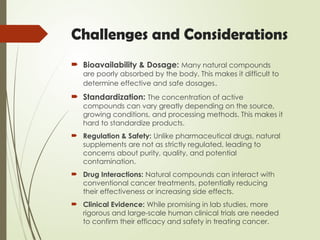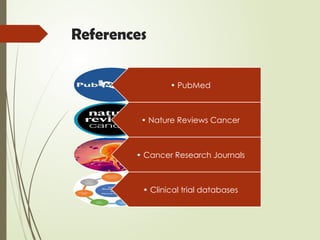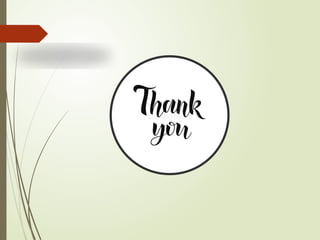Natural Anti Cancer Agents Presentation_pptx
- 1. Natural Anti-Cancer Agents Harnessing Nature for Cancer Prevention and Therapy Presented by: Date:
- 2. Introduction • Cancer is a leading cause of death worldwide. • Growing interest in natural compounds with anti-cancer properties. • Many natural agents are used in traditional medicine and have scientific backing.
- 3. Why Natural Compounds? Diversity: Vast range of unique chemical structures. Synergy: Multiple compounds working together for better results. Fewer Side Effects: Often better tolerated than synthetic drugs. Targeted Action: Can target multiple cancer pathways at once. Accessibility: Many are easily sourced from plants, fungi, etc. Historical Use: Many have a long history in traditional medicine.
- 4. Categories of Natural Anti-Cancer Agents Other Sources Marine Organisms: (e.g., compounds from sponges, corals) Microbial Sources: (e.g., some antibiotics and fungal extracts) Phytochemicals (Plant-derived) Alkaloids: Disrupt cell division. Example: Vincristine (from periwinkle). Terpenoids: Inhibit tumor growth and angiogenesis. Example: Taxol (from yew tree). Phenolic Compounds: Act as antioxidants and regulate cell signaling. Example: Curcumin (from turmeric), Resveratrol (from grapes). Flavonoids: Induce apoptosis and block cell proliferation. Example: Quercetin (from onions and apples). Saponins: Interfere with cancer cell membranes and induce cell death. Example: Ginsenosides (from ginseng).
- 5. Curcumin (Turmeric) Source: The active compound in the spice turmeric. Mechanism of Action: Anti-inflammatory: Inhibits NF-κB, COX-2, and inflammatory cytokines, which are all key players in the inflammatory response that can fuel cancer growth. Antioxidant: Scavenges free radicals, preventing DNA damage. Induces Apoptosis: Activates death signals (e.g., caspases) in cancer cells. Inhibits Angiogenesis: Blocks VEGF, a key protein that promotes blood vessel formation. Challenge: Poorly absorbed by the body (low bioavailability). Future: Promising for combination therapies, but not a standalone cure.
- 6. Resveratrol Source: A natural polyphenol found in the skin of red grapes, red wine, blueberries, and peanuts. Mechanism of Action: Antioxidant & Anti-inflammatory: Protects cells from oxidative stress and inflammation. Modulates Cell Signaling: Affects multiple pathways to inhibit cell growth and proliferation. Induces Apoptosis: Triggers programmed cell death in cancer cells. Challenge: Similar to curcumin, it has low bioavailability and requires high doses for potential therapeutic effects. Outlook: A promising area of study for cancer prevention and as an adjunct to other treatments.
- 7. Epigallocatechin gallate (EGCG) Source: The most abundant and potent catechin in green tea. Mechanism of Action: Powerful Antioxidant: Protects against DNA damage and oxidative stress. Inhibits Angiogenesis: Prevents the formation of new blood vessels that tumors need. Induces Apoptosis: Triggers programmed cell death in cancer cells without harming healthy cells. Blocks Cell Proliferation: Inhibits enzymes and pathways that promote cancer cell growth. Research Focus: Widely studied for its potential role in preventing and treating various cancers, including breast, prostate, and skin cancer. Key Benefit: Safe and well-tolerated, even at high doses, making it a good candidate for preventive studies.
- 8. Sulforaphane Source: A sulfur-rich compound found in cruciferous vegetables like broccoli, cauliflower, cabbage, and especially broccoli sprouts. Mechanism of Action: Activates Nrf2: Stimulates the body's natural defense system by activating the Nrf2 pathway, which boosts antioxidant and detoxification enzymes. Blocks Carcinogens: Helps the body eliminate toxins and carcinogens. Induces Apoptosis: Triggers programmed cell death in cancer cells. Anti-inflammatory: Reduces inflammation, a key driver of cancer. Research: Strong evidence supports its role in cancer prevention, particularly for cancers of the breast, prostate, and colon.
- 9. Quercetin Source: A flavonoid found in many fruits and vegetables, including onions, apples, grapes, berries, and broccoli. Mechanism of Action: Antioxidant: Neutralizes free radicals and reduces oxidative stress. Regulates Cell Cycle: Can halt the growth of cancer cells at different stages. Induces Apoptosis: Triggers programmed cell death in malignant cells. Anti-inflammatory: Inhibits inflammatory pathways and reduces cytokine production. Research: Shows potential in inhibiting the growth of various cancers, including breast, colon, and lung.
- 10. Marine-Derived Compounds Source: A vast and diverse source of new molecules from oceans, including sponges, corals, seaweeds, and microorganisms. Mechanism of Action: These compounds exhibit a wide range of anti-cancer properties, including: Inducing apoptosis (cell death). Blocking cell proliferation. Inhibiting angiogenesis (new blood vessel formation). Future: The marine environment is still largely unexplored and represents a highly promising frontier for discovering new anti-cancer agents.
- 11. Mushrooms Source: Medicinal mushrooms like Shiitake, Reishi, Turkey Tail, and Maitake have been used for centuries in traditional medicine. Active Compounds: Contain polysaccharides, especially beta- glucans, which are the main anti-cancer agents. Mechanism of Action: Immune System Modulation: They don't attack cancer cells directly but instead strengthen the body's immune system to fight cancer more effectively. Antioxidant: Provide antioxidant support to protect against cellular damage. Anti-tumor Effects: Some compounds have been shown to directly inhibit tumor growth in lab studies. Clinical Use: In some parts of Asia, mushroom extracts are used as an approved adjunct to conventional cancer treatments (e.g., chemotherapy, radiation). Examples: Krestin (PSK) and Lentinan are two well-known mushroom-derived drugs used in Japan.
- 12. Challenges and Considerations Bioavailability & Dosage: Many natural compounds are poorly absorbed by the body. This makes it difficult to determine effective and safe dosages. Standardization: The concentration of active compounds can vary greatly depending on the source, growing conditions, and processing methods. This makes it hard to standardize products. Regulation & Safety: Unlike pharmaceutical drugs, natural supplements are not as strictly regulated, leading to concerns about purity, quality, and potential contamination. Drug Interactions: Natural compounds can interact with conventional cancer treatments, potentially reducing their effectiveness or increasing side effects. Clinical Evidence: While promising in lab studies, more rigorous and large-scale human clinical trials are needed to confirm their efficacy and safety in treating cancer.
- 13. Current Research and Clinical Trials Focus on Combinations: A major area of research is using natural agents in combination with conventional treatments (like chemotherapy and radiation) to enhance their effectiveness and reduce toxicity. Well-Established Agents: Some natural compounds have already led to FDA-approved drugs. Examples include: Paclitaxel (Taxol): Originally from the Pacific yew tree. Vincristine: From the Madagascar periwinkle plant. Eribulin: A synthetic drug derived from a marine sponge compound. Improving Delivery: Scientists are exploring new methods to improve the absorption and effectiveness of natural compounds, such as using nanotechnology to create better delivery systems. Personalized Medicine: Future research aims to understand how natural agents can be used in a personalized way, targeting specific genetic pathways in individual patients.
- 14. Conclusion Promising Source: Natural compounds represent a rich and diverse source of potential anti-cancer agents. Multiple Mechanisms: They work through a variety of mechanisms, including reducing inflammation, acting as antioxidants, and inducing cancer cell death. Synergy is Key: Natural agents are often most effective when they work together or in combination with conventional therapies. Continued Research: While promising, more research and rigorous clinical trials are essential to validate their efficacy and safety. Important Caveat: Natural anti-cancer agents are a powerful area of research but are not a replacement for medical advice or standard cancer treatments. Always consult a healthcare professional. Final Thought: The future of cancer treatment may lie in a holistic approach, combining the best of conventional medicine with the potent power of nature's compounds.
- 15. References • PubMed • Nature Reviews Cancer • Cancer Research Journals • Clinical trial databases
















